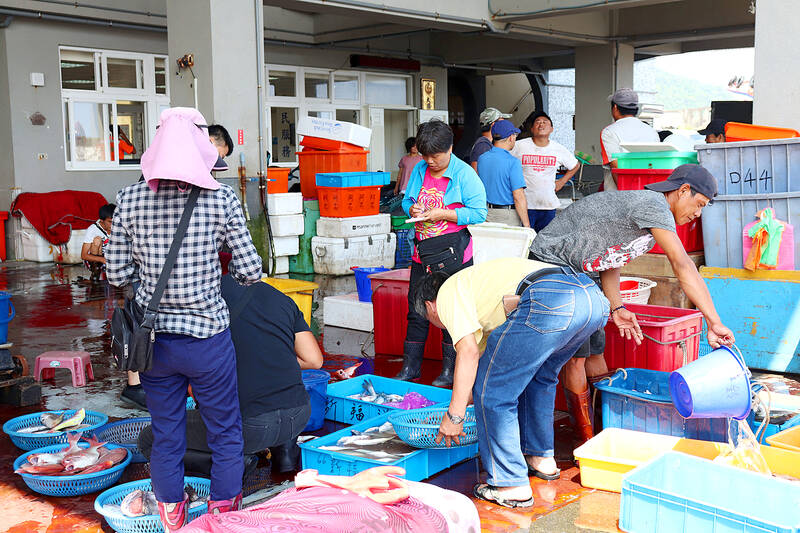Before the recall election drowned out other news, CNN last month became the latest in a long line of media organs to report on abuses of migrant workers in Taiwan’s fishing fleet. After a brief flare of interest, the news media moved on. The migrant worker issues, however, did not.
CNN’s stinging title, “Taiwan is held up as a bastion of liberal values. But migrant workers report abuse, injury and death in its fishing industry,” was widely quoted, including by the Fisheries Agency in its response. It obviously hurt.
The Fisheries Agency was not slow to convey a classic government defense, one that detailed each of the mentioned cases, and assured the public that the problem was a few bad apples.

Photo: Chiang Chih-hsiung, Taipei Times
“Taiwan has approximately 940 distant-water fishing vessels,” it averred a few days later. “The vast majority of vessel operators and captains operate legally, respect the rights and benefits of migrant fishers and prioritize safety at sea.”
It is quite true that most fishing boats operate legally — that’s the root of the problem.
The response followed the classic framing of the issue: systemic problems in the fleet vs individual captain behavior, with some complaints about the government being dilatory in making changes. That framing, accepted by so many writing on migrant worker abuses, avoids the heart of the issue: a key driver of migrant labor abuses is the government’s subsidy structures. The distant water fisheries (DWF) industry could not exist without them.

Photo: Lin Ching-lun, Taipei Times
LABOR LAW CUTOUT
The subsidies start with the labor law cutout for migrant workers in the distant water fleet. Taiwan has a total fishing fleet of over 21,000 vessels, with roughly a thousand operating in distant waters (the number could be much larger since many Taiwanese vessels fly flags of convenience). This fleet is generally considered the second largest DWF fleet in the world after China’s. Migrant workers constitute 62 percent of Taiwan’s DWF fleet labor, and 13 percent of coastal and offshore fisheries labor, according to 2023 Fisheries Agency numbers.
Migrant workers in the coastal and offshore fisheries are protected by the Ministry of Labor (MOL) and receive the basic minimum wage. By contrast, migrant workers in distant water fisheries are considered “overseas employees” and are regulated by the Fisheries Agency, not the MOL. They are paid less. A 2021 study in the journal Marine Policy calculated that they make roughly three-fourths of what their coastal and offshore brethren make (after deductions). For DWF workers, labor inspections and insurance are weaker, and limits on working hours much less restrictive. This regime was established in 2017 in response to the European Union giving Taiwan a “yellow card” in 2015 because of the widespread abuses in the fishing fleet. It used to be even worse.
Note that Taiwanese vessels sailing under flags of convenience are not subject to any Taiwan labor regulations.
WAGES AND DEBT
Low salaries and loose inspection regimes are an invitation to abuse. Another incentive is the visa system. Because the visa for coastal and DWF migrant workers is tied to their employer, the ship owner need merely terminate their employment and the worker is immediately deported. Migrant laborers typically take on debt to find a job, and cannot afford to be fired. The threat of instant deportation thus silences them.
The debt problem is also a deliberate creation of the system. Under Taiwan’s Action Plan on Fisheries and Human Rights, wages should be paid directly to migrant workers. However, as a study last year documented, most migrant workers are still paid by their recruitment agencies. Recruitment agencies can deduct money from fishers’ salaries to repay expenses and recruitment costs, effectively creating a cycle of debt for fisheries workers. Indeed, withheld wages have been cited in US Department of Labor reports on Taiwan’s fisheries fleet as a chronic problem. The lack of meaningful government intervention to stop this illegality acts as a subsidy.
It is remarkable how often one encounters this strange reluctance to intervene whenever migrant labor issues are explored.
FUEL
The fishing fleet is also the recipient of numerous direct subsidies. For example, Taiwan has offered the fishing fleet fuel subsidies since 1960. All other things being equal, subsidies increase the size of the subsidized sector. When industries grow large and unregulated, abuses proliferate. Further, before 2002 Taiwanese vessels were exempted from business taxes on “fishing boats for coastal or offshore fishery and machinery, equipment, nets and fuel used by fishing boats”. Their fuel subsidies were also much larger, but that year changes were made due to entry into the WTO. Fuel subsidies were slashed, but the business tax exemptions were retained, in response to anger from local fishermen. In 2005 Taiwanese vessels were equipped with electronic monitors which recorded their travels and permitted only subsidies for that, reducing subsidies again.
Most importantly, the Fisheries Agency operates a network of Fisherman’s Associations, one national and 39 local, with over 400,000 members. These are divided into three basic departments: economic, credit and services. Intended to help fishermen, they are responsible for a wide array of activities, helping with marketing, storage, and processing of products, loans and banking and services such as insurance and training. The local fishing industry could not exist, let alone operate a massive DWF fleet, without this supporting framework.
Reforms, such as putting the government instead of brokers in charge of migrant workers, or forcing fishing boat captains to install Wi-Fi to facilitate instant communication of problems (and help workers stay in touch with loved ones), are now perennial suggestions, perennially ignored. “Government foot-dragging,” so often the lens used to view government inaction, conceals more than it explains.
INTERNATIONAL PRESSURE
The existence of this comprehensive subsidy regime implies that the government has for decades had critical, powerful leverage over fishing boat captains, which it refuses to use to put a stop to the abuses.
There is some international pressure, but more is needed. The US Department of Labor last year listed Taiwan’s fishing industry on its List of Goods Produced by Child Labor or Forced Labor. It said that “workers face hunger and dehydration, live in degrading and unhygienic conditions, are subjected to physical violence and verbal abuse, are prevented from leaving the vessel or ending their contracts and are frequently not paid their promised wages or have food and lodging fees illegally deducted from their wages.”
In discussing the report, Greenpeace noted that “Bumble Bee — one of the main US canned tuna companies — is owned by Taiwanese tuna trader FCF and has been linked to Taiwanese fish caught with forced labor.”
The problem is not the nature of Taiwanese fishing boat captains or “a few bad apples.” Rather, the problems are created, shaped and controlled by the flows of government intervention and non-intervention. This non-intervention is not “foot-dragging” but obviously, considered policy. Clearly the government wants the problems dumped overboard at sea.
Which is, as Joe Henley pointed out to writer Sean Scanlon in an excellent AmCham 2023 piece on migrant fishery workers, what Taiwan fishing boat captains are legally allowed to do with the corpses of migrant workers who die aboard their ships.
Notes from Central Taiwan is a column written by long-term resident Michael Turton, who provides incisive commentary informed by three decades of living in and writing about his adoptive country. The views expressed here are his own.

We lay transfixed under our blankets as the silhouettes of manta rays temporarily eclipsed the moon above us, and flickers of shadow at our feet revealed smaller fish darting in and out of the shelter of the sunken ship. Unwilling to close our eyes against this magnificent spectacle, we continued to watch, oohing and aahing, until the darkness and the exhaustion of the day’s events finally caught up with us and we fell into a deep slumber. Falling asleep under 1.5 million gallons of seawater in relative comfort was undoubtedly the highlight of the weekend, but the rest of the tour

Youngdoung Tenzin is living history of modern Tibet. The Chinese government on Dec. 22 last year sanctioned him along with 19 other Canadians who were associated with the Canada Tibet Committee and the Uighur Rights Advocacy Project. A former political chair of the Canadian Tibetan Association of Ontario and community outreach manager for the Canada Tibet Committee, he is now a lecturer and researcher in Environmental Chemistry at the University of Toronto. “I was born into a nomadic Tibetan family in Tibet,” he says. “I came to India in 1999, when I was 11. I even met [His Holiness] the 14th the Dalai

Following the rollercoaster ride of 2025, next year is already shaping up to be dramatic. The ongoing constitutional crises and the nine-in-one local elections are already dominating the landscape. The constitutional crises are the ones to lose sleep over. Though much business is still being conducted, crucial items such as next year’s budget, civil servant pensions and the proposed eight-year NT$1.25 trillion (approx US$40 billion) special defense budget are still being contested. There are, however, two glimmers of hope. One is that the legally contested move by five of the eight grand justices on the Constitutional Court’s ad hoc move

Stepping off the busy through-road at Yongan Market Station, lights flashing, horns honking, I turn down a small side street and into the warm embrace of my favorite hole-in-the-wall gem, the Hoi An Banh Mi shop (越南會安麵包), red flags and yellow lanterns waving outside. “Little sister, we were wondering where you’ve been, we haven’t seen you in ages!” the owners call out with a smile. It’s been seven days. The restaurant is run by Huang Jin-chuan (黃錦泉), who is married to a local, and her little sister Eva, who helps out on weekends, having also moved to New Taipei